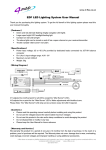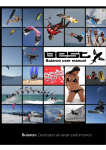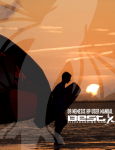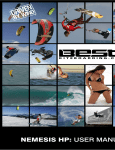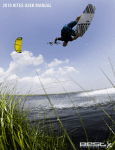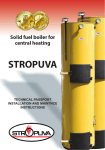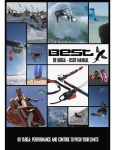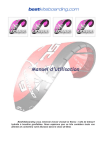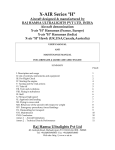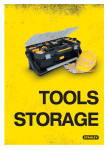Download Waroo Pro Manual - Best Kiteboarding
Transcript
1 BestKiteboarding thanks you for making the decision to purchase a new Waroo Pro SLE ‘supported leading edge’ inflatable kite, we are sure that this kite will repay your decision to purchase Best by providing you with faultless service for many seasons. In fact, we are so sure of this that we guarantee it, if for any reason at all, you are not satisfied with your purchase simply send it back to the retailer you bought it from or BestKiteboarding.com and we will refund you the purchase price of your kite, this is in addition to our industry standard 90 day materials and manufacture guarantee. With one of the largest pro-rider teams in the world, Best Kiteboarding also has one of the best R&D test beds in the industry. With our dedicated R&D facility based in Brazil being staffed year round you can be sure that everything we make has been tested to the ends of the earth and back. Our Brazil R&D site is open whenever there is wind, if you are in the area and want to see and try the latest products that we have in development, call in, we value the feedback. After all we make kites for our customers to ride and enjoy, not just for ourselves. BestKiteboarding is staffed and run by kiteboarders for kiteboarders. We entered the market with the sole purpose of delivering the highest quality and best performing kites available anywhere at the fairest prices. Because Best Kiteboarding distributes direct to retailers and customers our overheads and running costs are much less than any other manufacturer. Even though our kites cost the same to manufacture and in some cases like the Pro-kites, much more to build, we still sell them at prices way below the industry average. Bestkiteboarding’s sales model is simply a more effective way of manufacturing and selling kites than used by other manufacturers, and the end result is that we build more kites and sell them to more happy customers than anyone else, so everyone wins. Waroo Pro: SLE Inflatable Kite The Waroo Pro represents the culmination of over two years R&D into advanced materials and high projected area kite design and is the most technically advanced SLE kite on the market. The Waroo Pro is a ‘Supported Leading Edge’ inflatable kite, or SLE, this design differs from previous Cshape kite layouts in that the kite has a greater projected area which enables a more efficient kite design that delivers greater upwind performance, depower and safety. The structure of SLE kites receives additional support from a simple bridle system, this allows for the increased projected surface area, and also facilitates the extended depower and safety by moving the front pivot points for the entire kite outside of the space bounded by the kite canopy. The Waroo Pro uniquely has self adjusting pulleys attached to both the front and the back of the kite. The front pulleys assist with depower and safety activation, whilst the rear pulleys increasing 2 turning speed, stability and assist with faster relaunch. Unlike most other SLE kites the Waroo Pro does not rely on bar mounted pulleys to achieve its excellent turning and quick depower rates. The SLE design, including a 4-point bridle system, and virtual front and rear “V” point attachments for variable AOA stability, deliver all the benefits of huge de-power, fast turning, improved safety and instant re-launch in one single kite. Waroo Pro Kite Package: Your new Waroo Pro kite comes complete with travel bag, alloy shafted inflatable pump, repair kit and this user manual. All that is required to make the kite ready for flying is the attachment of a suitable bar and lines package and you are ready to ride. Details and Set-up Instructions: The Waroo Pro is shipped with all bridle lines secured to the center strut valve retaining Velcro. When you receive your kite, unroll your Waroo Pro and remove the foam valve protectors. Next detach the bridle lines from their position on the center strut and separate the bridles into left and right. (these are color coded, Red for the left side and Blue for the right side). Front : The front attachments are comprised of a leading edge bridle that terminates on both sides with a closed loop (larks head) and replaceable section that the pulley travels on. Should signs of wear show on either the pulley or bridle contact your nearest dealer for replacement parts. Riders should perform a thorough inspection of their kite each time they set-up and prior to launching; to ensure that it has sustained no damage during use. Any damage should be repaired by a professional kite or sail loft to ensure continued safety and usability. Rear: The rear flying line attachment on the Waroo Pro is comprised of two lines that join to form a ‘Y’ shape bridle. The upper ‘V’ includes a pulley which the pigtail is attached to. Together this ‘Y’ shape bridle allows for distribution of turning force across different parts of the canopy.’ Inflating and Anchoring the Kite: When unpacking and inflating your kite for the very first time, partially inflate each strut in sequence and massage the bladder through the strut material towards the top and bottom of the strut, this will ensure that each bladder is perfectly seated in the strut pocket. Once ready to complete the first inflation of your kite, stand with your back towards the wind and lay the kite out, lengthways, downwind of you, with the struts facing upwards. Place sand on the 3 upwind wingtip to secure the kite during inflation. Starting with the centre strut inflate each section of the kite to the required air pressure. All struts should be inflated until they are free from creases and unyielding to light grip pressure from your hand. If you have the use of a calibrated pressure gauge this should read around 8psi, any more pressure than this in the struts in unnecessary and will not further improve flight performance. For maximum relaunch performance it is important that the struts be inflated correctly. Once all the struts are inflated move onto the leading edge. The reduced diameter leading edge of the Waroo Pro requires inflation to around 9PSI. Inflated to the correct pressure the zero stretch Cuben/Dacron hybrid cloth delivers a much stiffer LE and more results in more responsive flight characteristics. To inflate the leading edge ensure that the deflate valve is fully seated and that the top of the valve cap is flush with the stem of the valve. Once the deflate valve is securely closed, attach the pump leash to the centre bridle point by looping the end of the pump leash over the bridle and passing the stopper ball back through the small loop at the end of the pump leash. Inflate the leading edge until all small wrinkles are removed, the LE should give ‘ping’ when flicked with a finger once fully inflated. A correctly inflated kite should give heavy resistance to the pump on the last few strokes, do not try to inflate the LE to the limit of the pump. If you have the use of a calibrated inline gauge the correct LE inflation pressure is around 9PSI. Correct inflation pressure will vary slightly with kite size, the smaller models will require slightly more pressure and the larger kites slightly less; this variance is likely to be no more than half a PSI in either direction. 4 Trouble shooting bladders: The strut bladders on the Waroo Pro are thin to aid flight performance and require to be pumped up to a relatively high PSI, 8.5 PSI is recommended. When reseating the smallest strut bladders, if the bladder and pocket are not completely dry there is potential for the bladder not to completely fill the end of the strut. Please ensure that the strut pocket material and the bladder are completely dry before reinsertion, adding copious amounts of talc to the valve-end of the bladder sill suffice in most cases. If you are concerned that your bladder may not be fully seated, try the following. With the bladder inserted into the pocket, and with the valve seated through the valve hole, but still exposing the tail of the bladder through the small end of the strut pocket, take a length of plastic tube and a funnel and carefully pour around 1 pint of water into the strut. After closing the valve pick up the strut by the thin end, and holding both the strut pocket and the tail of the bladder in your hand, shake the strut so that the weight of the water pulls the bladder end completely towards the back of the leading edge. Do not inflate the strut until the tail of the bladder is safely seated inside the pocket and the end of the strut folded over with the Velcro closed securely. With the end of the strut securely fastened and the tail of the bladder folded inside, inflate the strut gently and shake again. This will ensure that the bladder is fully seated. Then angle the strut so that the valve is at the lowest point and deflate the strut to release the water. Inflate and drain the bladder one more time to ensure you have removed all the water. The water will not harm the bladder in any way but excess retained water may affect the balance of the kite in flight. Launching the Waroo Pro on the Beach: The Waroo Pro launches much like any other LEI kite; the only difference being that the rider must take care where they position the bridle lines prior to launch. Make sure the bridles and flying lines can not get tangled. The Waroo Pro has line deflectors on the strut ends to assist in this. With the kite inflated correctly and all the flying lines attached to the correct bridle points the rider should st place the kite at the edge of the wind. They should then place sand on the inside of the kite behind the 1 nd strut towards the 2 strut, this helps to keep the kite flat to the wind until the wingtip has been folded over and secured with more sand. Fold the wingtip over on the Dacron part of the leading edge, the Dacron is easier to bend than the Cuben section, and then sand down the folded wingtip. Before going back to your bar to launch, wait at the kite for a while to ensure you have placed enough sand on the kite to hold it down. Retire upwind to the bar, hook into the Chickenloop, and take a second to check your lines visually one last time. With the bar firmly in your grasp and the bar positioned at 50% depower position, pull the top of the bar towards you and step backwards. 5 Pulling the bar back towards you and stepping backwards will flick the sand off the wingtip, releasing the kite and allowing it to self launch. Landing the Waroo Pro Due to having dual rear line ‘oh-shit’ handles and it’s unique bridle layout landing the Waroo Pro is much easier than with other SLE kites. Two simple methods can be used to land the Waroo Pro, depending on your personal preference and the wind conditions. Method 1: This method is suitable for most wind speeds on open beaches, with sufficient free space downwind. Fly your kite to the side of the window leaving the kite at an angle of about thirty degrees to the ground. With your kite at the edge of the window; sheet-out, reach up and grab the lower of the two ’oh-shit’ handles. With the webbing loop firmly in your grasp, unhook while holding onto the webbing handle. The Waroo Pro will fly slightly to the edge of the window, and then loop under itself, coming to rest on the beach in the dead downwind position facing into the wind with the leading edge facing up. please note: this method is only recommended if you have more than two line lengths of downwind space. 6 Self-landing the Waroo Pro: Method 2: To land the Waroo Pro in higher winds fly it down to the ground at the edge of the wind window, so that the lower wingtip touches the sand. Clip your leash to the webbing on the ‘oh-shit’ handle that is now facing upwards on your bar. ie. if you landed the kite on its right wingtip, then clip into the left hand side ’oh-shit’ handle. Pull gently on the handle to loosen the retaining Velcro. Reach up and pull the trim strap all the way in to fully depower the kite and then unhook from the bar holding the bar equally in both hands. Quickly check that you hooked correctly into the safety handle and then simply drop the bar. The kite will flag out into the wind with the canopy facing upwards. Practice this a few times in lighter wind to get the hang of the routine. If you ever feel unsure of your ability to land in this way due to hugely increased wind speeds then ask for an assisted landing. Water relaunching the Waroo Pro The Waroo Pro has ‘built-in’ relaunch capability. With the kite’s leading edge down in the water simply pull on either of the back rear lines and the kite will taxi across the wind window, take an upright position and await relaunch by a swift upward pull on the bar. In lighter winds it may be beneficial to use your board to create extra resistance to the pull of the kite, to enable faster relaunch, and to speed the kite taking an upright position at the edge of the wind window. Once in this position simply adjust the bar and steer the kite launching it upward. Advanced downwind re-launch techniques can also be used. Some terms are ‘hot-launching’ and reverse launching. Hot launching. With the kite resting on its trailing edge in the water with its weight partly supported by the struts, it is possible that the kite may accidentally ‘hot launch’. As soon as the kite powers up you must sheet out the kite, front line load only. The rear lines must not have any tension until the kite is safely in the neutral zone, in this case that would be overhead in the zenith. Reverse launching. When the LE is downwind and away from you, using the rear lines a reverse draft can be created using the trailing edge, which causes the kite to hover up backwards. If both rear lines are pulled with even tension the kite will hover up evenly balanced. If one rear line is pulled a few CMs the kite will hover up and start to redirect. In this case be prepared to flip the bar and sheet-out the kite to reduce powering up the kite in a downwind position. 7 Assisted Landing the Kite When landing your kite with an assistant simply fly the kite to the edge of the window and down to ground level slowly. Have your assistant the take hold of the kite firmly in the middle of the leading edge, and then walk towards your assistant to remove all flying line tension. You can either have you assistant lay the kite down and sand the upper canopy, or have them hold the kite until you are unhooked from the bar and safely able to have them hand the kite over. FAQ What type of performance can I expect from my 07 Waroo Pro ? Expect the ‘best-performance’, the most user-friendly and safest kite available at this time on the market! The Waroo Pro is not only used by schools, but many advanced riders prefer the flatter profile because of the huge amount of de-power available in a short amount of throw. Surfing waves has never been more do-able. With the ability to shut the kite down you can now ride the board more than ever, letting the wave provide the acceleration when wave riding and using the kite as a primary or supplemental power source. Throwing tricks (hooked and un-hooked) can be a safe way to accelerate the learning curve, due to the auto de-powering effect initiated by dropping the bar. How do I adjust the turning speed and feel of my kite? The Waroo Pro uses a new rear line pulley set up based around a simple V shaped bridle, this system automatically adjusts the distribution of turning force between the two rear attachment points. Unlike the system used previously on the Waroo 06 the new set-up automatically compensates for bar position, adjusting bar pressure and turning speed. Whilst the stock setting is the preferred set-up for most riders we have included a small stopper knot in the rear line that can be repositioned to limit the amount of pulley movement. In addition to the larger stopper knot there is also a ‘reference knot’ on the rear V-line, this reference knot is there solely to act as a reference point for positioning the stopper knot, do not remove it. Moving the stopper knot away from the ‘reference point’ will reduce the maximum bar pressure and increase the minimum turning speed of the kite. This allows any rider to trim the handling of their kite to suit their skill level and preferred style of kite handling How should I care for my Waroo Pro? Inflate and deflate your kite with care. Follow proper inflation techniques and pack down your kite when it is completely deflated and dry. Do not leave the kite inflated sitting on a windy beach unused for long periods of time, flapping in the wind. Inspect the kite periodically for small holes or tears and patch when detected to eliminate costly repairs. How should I pack my Waroo Pro? The easiest way to pack your Waroo Pro is to lay the kite flat, fold over the LE into the kite, then folding the kite is half lengthways, and then roll the kite loosely from tip to centre. With the kite rolled up, take the trailing edge and fold it over twice towards the LE to expel any remaining air from the bladders 8 How do I Remove and Install a Bladder? Typically the bladder should last the life of the kite, however unforeseen things happen. If you should need to replace a strut or LE bladder make sure it is sized for your kite. Order specific Waroo Pro replacement bladders. Whilst protected inside the LE and struts bladders are incredibly robust, when taking them out ensure that they are placed on a clean, dry and grit free surface. You will require 2 lengths of line, preferably an old flying line with a closed loop still attached. Each length of line needs to be about 6 feet longer than half the wingspan of the kite Removing Bladder Undo the LE access zip; make sure that the zip is clean and free from sand before proceeding. If the zip is jammed with sand flush it out with a small amount of water or blow the zip clean using the pump. Once the zip is open push both the inflate and deflate valve stems inside the LE. Unfold the wingtip pockets, the black ABC-cloth flap is retained with a small Velcro tab, undo the Velcro and pull the end of the pocket out from the end of the sleeve. Gently pull 10-15cm of bladder out from the sleeve. All bladders are oversized so there will be suitable excess material at the end of the pocket. Take your length of line and carefully loop it around the end of the bladder, cinch the line up against the bladder end so that is tight and secure. Repeat for the opposite end of the kite. When you pull the bladder out through the zip at the centre of the LE the line will pull through the length of the LE. This line enables you to pull the bladder back towards to wingtips and it is essential for reseating the bladder correctly. With the lines attached to both ends of the bladder gently pull the bladder out through the LE. Repeat this for both sides of the kite until the bladder is completely withdrawn from the LE and both pieces of line attached to the bladder ends are poking through the LE zip. With the bladder completely withdrawn from the LE, detach the lines from the ends of the bladder and carefully fold the bladder from tips to centre so that the bladder folds up like an ‘accordion’ on either side of valve stems. For re-inserting the bladder it is important that both tips are in separate piles/folds, as this allows you to insert the bladder one side at a time without tangling the ‘spare’ side of the bladder during re-insertion. 9 Re-installing the bladder Before you attempt to reinsert the bladder it is essential that the bladder and the LE sleeve are both completely dry. Sprinkling the bladder with copious quantities of ‘talc’ will make refitting the bladder much easier. Lay the folded bladder on the LE next to the open zip, the bladder should be laid out so that the two valve stems are facing upwards with no twists being visible in the bladder. Carefully taking one end of the bladder attach the end to one of the lines that you previously drew through the LE. Then attach the other end of the bladder to the remaining line. Carefully feed the bladder into the LE sleeve one side at a time until all the bladder is neatly folded up inside the LE sleeve. From the wingtip, carefully and slowly pull the bladder down the LE sleeve using the lines attached to the bladder tips. Once the bladder is exposed at both ends of the kite return to the centre of the kite and seat the inflate and deflate valves through their reinforced holes in the LE and close the LE zip. Returning to the wingtips, detach the lines from the tips of the bladders and carefully fold the bladders tips up into the ends of the wingtip sleeve. Carefully fold over the end cap and securely fasten the Velcro pieces together ensuring the bladder cannot poke out once inflated. Once the LE zipper and wingtip closures are sealed, slowly inflate the LE and observe bladder inflation. If the bladder has been twisted during installation, it will show up as a void in the area of the twist. The area may be massaged at a low air pressure to relieve the twisted bladder. If this does not work the bladder may need to be uninstalled and reinstalled correctly to eliminate the twist. If the bladder appears to be difficult to pull through the LE lightly coat the bladder with talcum powder once more and try again. Wind Ranges The suggested wind range chart is just that; a ‘suggestion’, always know your limits and when in doubt rig a smaller kite and use a larger board. Depending on your riding technique and the position of your stopper ball it is possible, though not advisable, to ride outside of the stated wind speeds and still retain complete stability of the kite. If you can’t keep your kite stable at wind speeds approaching or above the upper stated limits for each size kite then please do not attempt to exceed your skill level. 10 Why does the Waroo Pro have a simpler bridle and no bar mounted pulleys when compared to other SLE kites? The Waroo Pro was carefully designed to have reduced depower travel and lighter bar pressure than other SLE kites with fewer bridle pulleys. Extra pulleys at the bar add more bar pressure. For 07 we believe other brands may copy this approach and set up. What is the bridle used for? The bridle supports the flatter shape and reduced leading edge of the Waroo Pro. With specific attachment points it allows greater power from a higher projected area, making it a more efficient kite. In combination with the front pivot placement it also allows the Waroo Pro to have a huge amount of depower. Can I use a bar from other kites on the Waroo Pro? Yes, however certain precautions need to be taken in consideration when using other bars. It is best to seek technical assistance before rigging a ‘non-Waroo bar’ to the kite. The Waroo-Pro bar is designed to be specific to the Waroo kites, its extended travel allows for complete depower of the kite, this is key to the improved safety of the Waroo Pro over a ‘C’ shaped kite. An upgrade kit is available that includes everything but the bar and lines for swapping any 05 Best bar over to be suitable for the Waroo Pro. For details of the new 07 bar please visit the Best Website How hard should I pump my Waroo Pro kite? To the specified PSI ratings, we recommend 8.5-9psi for the Waroo Pro; smaller kites require slightly more inflation than larger kites. An under inflated kite will be problematic through the flight cycle and relaunching. Does the Waroo Pro invert like other SLE kites? Some SLE kites have shown tendencies to invert when fully de-powered or at the high end of their wind range turning inside out during flight. Precautions for inversion have been taken in consideration with the design of the Waroo Pro, such as profile shapers, tow point limiters at the front bridle and a variable rear bridle. These variable points help stabilize the AOA of the kite when fully de-powered or at the high end of the kites wind range. As with any kite, if flown incorrectly or outside of it’s stated wind range, it can be made to misbehave. What safety systems are built into the Waroo Pro? A Waroo Pro flown with a Waroo bar has multiple redundant safety systems. First and foremost releasing the bar and allowing it to slide up to the trim strap will depower the kite to be handled in a safe manner. Both back flying lines on the Waroo bar are equipped with ‘oh-shit’ handles; these can be used in conjunction with depowering the kite to completely flag the kite out to a powerless position. A leash can also be clipped to the webbing handles for use on the water. How do I rig my Waroo Pro, what attachment knots should I use? All Waroo Pros come with 6 knots already tied on the bottom of the rear flying line attachment bridle, the Waroo Pro is designed to work best for riders of average weight when the flying lines are attached to nd rd the 2 or 3 from bottom knot on the rear bridle. When attaching for the first time please use the bottom knot on the bridle, if the kites handling and turning is sluggish then re-attach top the next knot up. Repeat this procedure until you have found the perfect knot position for your arm reach and your 11 preferred riding style. When the kite is trimmed correctly you should be comfortable enough to steer the kite and still have enough reach left to depower the kite by pushing the bar away from you. As an additional passive depower adjustment the trim strap allows further depowering on the fly. If you intend on riding unhooked for performing tricks it is important that you trim your kite so it does not back stall when unhooked. To check this once you think you have found your preferred rear knot setting, unhook the chicken loop from your spreader bar and fly the kite overhead. If the kit sits directly above you with no backing down, then you have the perfect trim. If you find the kites wants to back down towards the beach then you have too much rear line tension and the kite is oversheeted. To fix this simply pull down on the depower strap in small increments until the kite flies happily overhead with the bar unhooked. Please note that flying unhooked is not recommended unless you are already comfortable with the increased level of kite control required. Never try to asses the correct trim for unhooking in high winds and never unhook without using a rated safety leash designed for this purpose. How do I perform a self-rescue with my Waroo Pro? If possible, release the OSR handle to flag the kite and wind the lines onto the end posts. Hold the bottom of the kite near the first or second strut (it doesn’t matter too much which). Then grab the part of the LE bridle that attaches closest to the wingtip, approximately 1-2ft from the LE attachment point. Once the kite is trimmed well--powered, but not dragging downwind you can sail downwind easily. How do I pack my Waroo Pro: As your Waroo Pro uses battens in the leading edge and trailing edge, you need to consider this as you pack your kite away. To ensure you do not damage your lightweight battens during packing always roll your Waroo Pro from the wingtips to the centre ensuring that the leading edge forms a straight line in the finished roll. Once the kite is rolled up, find the ends of the trailing edge battens and fold the kite in thirds from this point towards the leading edge. With the kite fully rolled all the trailing edge battens should be in one third of the roll and all the leading edge battens should be in the first third of the roll. How do I replace worn bridles on the Waroo pro? The Waroo Pro front bridle has user replaceable heavy duty inserts fitted into the centre of the line. Should these become worn then simply undo the retaining loops at either end and fix in place a replacement set. It is recommended that you replace both sides at the same time even it only one side is showing wear. Introduction to performance features: The 2007 Waroo Pro is the most technically advanced, best performing kite ever made. With a reduced diameter Cuben Fiber leading edge, exclusive new "Canopy Framing Technology", profile shapers, surfproof construction and countless other features, the Waroo Pro is simply the perfect kite. The Waroo Pro has handling to match its technical excellence, it delivers more explosive pop and greater hangtime than any BOW, SLE or C kite, while still delivering maximum depower, unmatched stability and multiple integrated safety systems. The Waroo Pro is not just for professional riders; it's for any rider who can stay upwind, in fact for anyone who wants to boost higher, hang longer and simply have more fun kiteboarding. With that in mind we have included a list of all the technical features on the Waroo-Pro. The better you know your kite, the safer you will ride. 12 REDUCED DIAMETER CUBEN LEADING EDGE: Simply the stiffest most responsive leading edge on the market, with a significantly reduced profile that slices through the wind for amazing upwind and jumping ability. Cross acting spectra fibers built into the material enhance responsiveness and torsional load distribution EXCLUSIVE CANOPY FRAMING TECHNOLOGY: Kite-wide continuous reinforcement and load distribution zone. Helping to transfer turning loads across the entire canopy for the fastest response to flying inputs. High impact distribution zone separates the canopy from airframe loading during heavy crashes. SURF TOUGH CONSTRUCTION. a three layer triple stitched seam with a full length webbing wrap, designed to better absorb the shock of big wipe-outs. The toughest LE seam is market is also rotated out of the way behind the LE to improve under canopy airflow. HARMONIZED ARC: Size specific leading edge curvature, ensuring the perfect ratio of lifting to control surface. Every size of kite has a precision designed and tested blend of performance and handling to deliver maximum levels of user friendliness. EXCLUSIVE CUBEN FIBER MATERIAL: Setting the standard in materials technology and performance, our unique CubenDacron Hybrid leading edge material delivers the amazing load handling and distribution properties of Cuben with the abrasion resistance and easy handling of Dacron. Cross acting spectra fibers built into the material offer amazing torsional stability, responsiveness and durability. MAXIMUM PERFORMANCE STRUT PLACEMENT: Proven performance from reduced weight and improved under canopy airflow. The Waroo-Pro weighs less than any other SLE kite on the market, and delivers greater ease of use, durability and unmatched performance. PERFECT PROFILE SHAPERS: High modulus glass fiber reinforced battens, flexible enough to bend tip to tip without breaking, stiff enough to provide the canopy with maximum support enabling faster flight and exceptional upwind ability. FLUID POCKET BATTEN MOUNTS: EVA padded and webbing reinforced batten pockets, separate the canopy from direct contact with the battens and eliminates potential wear points previously associated with battened kites. We finish each item of canopy protection off with a layer of Mark cloth to ensure your lines don’t get snagged on your canopy at any time. LEADING EDGE BRIDLE SCUFF PADS: Strategically placed LE scuff pads eliminate bridle contact with the LE. Whether riding on snow water or land, the Waroo Pro is built to withstand any punishment you throw its way. FLUID POCKET CANOPY PROTECTION: EVA protection pads with flat locked edges on all canopy protection and batten pockets to ensure zero line ‘hang ups’ when self launching, and maximum kite protection from impacts, on or off the water. 13 PERFORMANCE MATCHED SIZING: Every size of Waroo-Pro is designed to have the exact same feel and responsiveness as every other size, so jumping from a 15m to a 9m takes no rider adjustment. Every kite from the smallest to the largest delivers massive hangtime and unreal upwind performance. SERVICABLE FRONT BRIDLE INSERTS: Woven spectra pulley lines for maximum durability and smoother handling. Plus in the event that a bridle wears through, replacement is a snap. PERFORMANCE PROFILING: Custom shaped from tip to tip, to deliver the best riding experience, with unmatched responsiveness, depower and upwind ability the Waroo Pro is ahead of the curve. TRAILING EDGE BATTENS: Your Waroo Pro is guaranteed never to flap during normal riding. Battens also work in conjunction with Best’s exclusive Canopy Framing Technology to yield unmatched responsiveness and stability . ABC CANOPY PROTECTION: Ultra durable, upper canopy protection. Strategically placed ‘ABC’ guard cloth protects the canopy and leach line from the worst the beach has to offer. ABC STRUT PROTECTION AND BLADDER END CAPS: ABC cloth with enlarged Velcro fastening protects the strut ends and keeps the bladders locked in place. SELF TENSIONING LINE DEFELCTORS: Elasticated flying line deflectors, to stop your lines getting wrapped around the strut ends even when you roll your kite in the toughest conditions. Line deflectors also provide additional trailing edge tension during powered up unhooked loops to eliminate trailing edge flutter. SELF-ADJUSTING REAR ‘V’ BRIDLE: Perfect load distribution through the canopy at all depower positions gives faster turning response and tighter turns, even when unhooked. Variable rear line ‘V’ bridle delivers perfect bar feel and helps eliminate canopy flutter without adding excess flight weight. COLOUR CODED LEADING EDGE BRIDLES: A practical solution to rigging the kite correctly every time. Each side of the kite has the bridle constructed in a different color zero stretch line, helping you to rig it right first time every time. EASY PULL VELCRO VALVE TABS: Redesigned extended Velcro tabs with increased closure surface secure the valve stopper with maximum ‘hold down’. Faster pack up and set down even with gloved hands. 14 HIGH VOLUME LE DEFLATE VALVE: Larger valves for faster pack down, tested and proven to work flawlessly in any environment, from the heat of mid-summer in Northern Brazil to the incredibly harsh weather of winter time Norway. DOUBLE BAGGED BLADDER ENDS: All bladder ends in the Waroo-Pro come double wrapped with an extra thick layer of TPU bladder material, the best combination of lightweight performance and durability. RONSTAN PULLEYS: For 07 we’ve chosen uprated high load pulleys from the most respected manufacturer in the industry. With greater bearing clearance and an improved low friction pulley wheel surface they are designed to provide smoother running and minimal maintenance no matter how you look after your kite. CFT REINFORCED TRAILING EDGE: Canopy Framing Technology includes a reinforced trailing edge that provides razor sharp responsiveness and unmatched durability, even if you leave your Waroo Pro lying on the beach for days or months on end HIGHEST QUALITY MATERIALS: The 2007 Waroo Pro uses only the best available materials and construction. Where we can find them we buy them, when we can’t we work with companies to develop materials to our exact requirements. Alongside our exclusive Cuben Fiber cloth you’ll find Dacron from Dimensional Polyant, respected as the maker of the absolute finest, toughest and most expensive Dacron on the market. The canopy Rip-stop is sourced from Teijin, who .provide the Waroo pro with the lightest and toughest Rip-Stop in the industry. SOLID AIRFRAME CONSTRCUTION: The Cuben Fiber leading edge of the Waroo Pro, Bests innovative Canopy Framing Technology, harmonized arc, Rigid Strut design and profile shaper cam battens all come together to form the most rigid, dependable and highest performing kite airframe on the market. Wrapped up in a precision shaped and constructed canopy there simply is no better performing or easier to use kite available. If you have any questions about your Waroo-Pro that are not covered in the user manual, please contact your nearest dealer or BestKiteboarding directly. 15
















